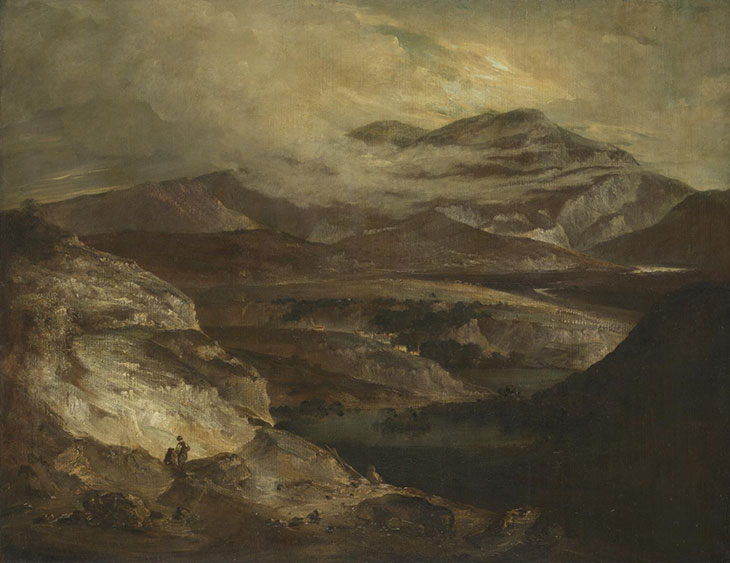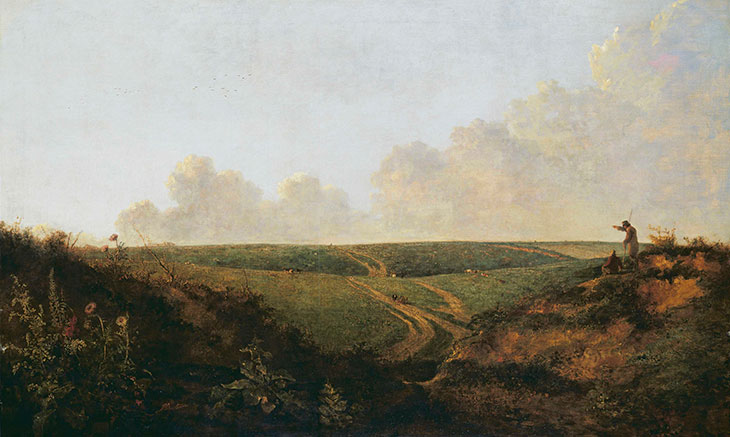In the eyes of Henry James, he was a ‘man of genius’; to Clive Bell he was perhaps the only English painter who ‘could conceive and effectively carry out a work of art’; and when in 1923 Charles Collins Baker, then keeper of the National Gallery, declared that he ranked alongside Turner and Constable as one of Britain’s ‘three greatest masters’, few would have disagreed. But while Turner and Constable’s positions in the canon of British art remain unchanged, today you would be forgiven for not having heard of the painter John Crome.
On the bicentenary of his death, however, an exhibition of his work at the Norwich Castle Museum is an opportunity to reintroduce the public to this half-remembered luminary of English art. With a selection of works from across Crome’s career in a range of different media and including loans from the Tate, the Fitzwilliam Museum and the National Gallery, this exhibition certainly makes the case that his is a name which should be better known.
Slate Quarries (c. 1802–05), John Crome. Tate Collection

The point is made with startling force at the start of the exhibition with Slate Quarries (c. 1802–05), an early oil on canvas by Crome. Painted either in the Lake District or in Wales, it depicts the view across a valley to a mountain peak, half hidden by swiftly passing clouds. It’s a classic Romantic topos. But what Richard Wilson, a few decades earlier, would have saturated with Italianate light or Turner – who is said to have owned the painting – might have transformed into a struggle of man against nature, Crome’s scumbles of white paint on a characteristic dark-red ground suffuse with a mystery that seems to make no point other than to highlight the solemn grandeur of nature. It’s a mood that’s entirely his own, and that instantly demonstrates the individuality of his artistic voice.
In his mature works, Crome’s singularity becomes more apparent still. In his etchings (which have suffered much from the attempts of a former pupil, Dawson Turner, to finish them after Crome’s death) he made a unique attempt to introduce the spontaneous quality of the sketch to the mechanical printmaking process. Working in oils in Mousehold Heath (c. 1818–20), which when bought by the National Gallery became his most popular painting, Crome succeeded, using only a clump of wildflowers in the left foreground and a gathering mass of clouds on the upper right, in transforming the gently sloping hills of the Norfolk countryside into a dramatically compelling image. Is the figure standing on the mound on the right of the foreground introduced to make a comment or simply to draw the viewer’s eye in? We won’t ever know, but Crome subtly introduces a tension that makes us wonder.
Mousehold Heath, Norwich (c. 1818–20), John Crome. Tate Collection

Why, then, his relative obscurity today? Part of the answer is that Crome’s humble origins meant his career was based largely in Norwich. The son of a weaver and publican, Crome trained as a painter of pub signboards (one of which, a rare survival, is included in the show). Though the city of Norwich was prosperous, and Crome, as a founding member of the Norwich Society of Artists – the first artistic association of its kind – was one of its leading artistic figures, it lacked London’s highly developed art market and the associated opportunities for professional advancement. On top of this, Crome simply did not produce as much as his peers. A late starter, he exhibited his first work at the Royal Academy in 1806 aged 37, giving him only a further 16 years before his death. Constable and Turner, by contrast, had considerably longer careers. As a result, the total corpus of Crome’s works of around 118 paintings and 98 drawings is meagre compared to the 2,500 paintings and drawings of Constable’s known output and the staggering 550 paintings and 32,000 drawings produced by Turner. And unlike Turner, Crome made no great institutional bequests to secure his legacy.
The most significant factor of all is the problem of attribution. Crome never signed his works and his style was much imitated, particularly by the pupils whom he taught to make his living (a modest man, he saw himself as a ‘drawing master’ first and as a painter second) – foremost among them his son John Berney Crome, a landscape and marine painter. Later in the 19th century, meanwhile, Crome’s prices began to climb – particularly following the 1862 International Exhibition in London at which seven of his works were exhibited – prompting a significant number of convincing forgeries to enter the market. The problem is so bad that the authors of the exhibition catalogue estimate that there may be as many as ‘several hundred works attributed to him that he did not paint’.
As the first exhibition dedicated to Crome’s work since 1968 (the accompanying catalogue is the first monograph on the artist since 1978), the exhibition at Norwich Castle Museum has tried to resolve some of these questions through technical analysis. But much still remains to be done if some clarity is to be introduced to Crome’s body of work. For now, here is a welcome occasion to become better acquainted with a little-known figure who truly deserves his place in Britain’s artistic pantheon.
‘A Passion for Landscape: Rediscovering John Crome’ is at Norwich Castle Museum until 5 September.



